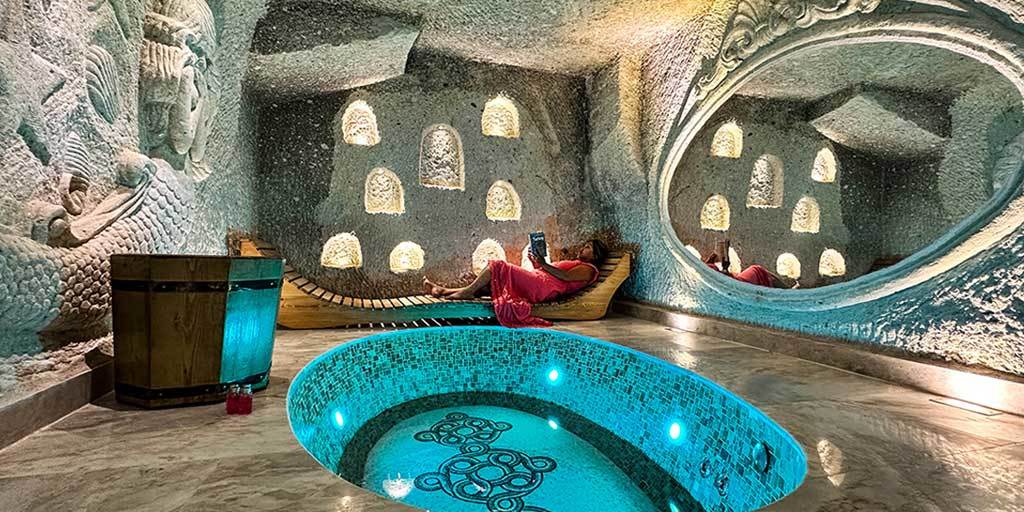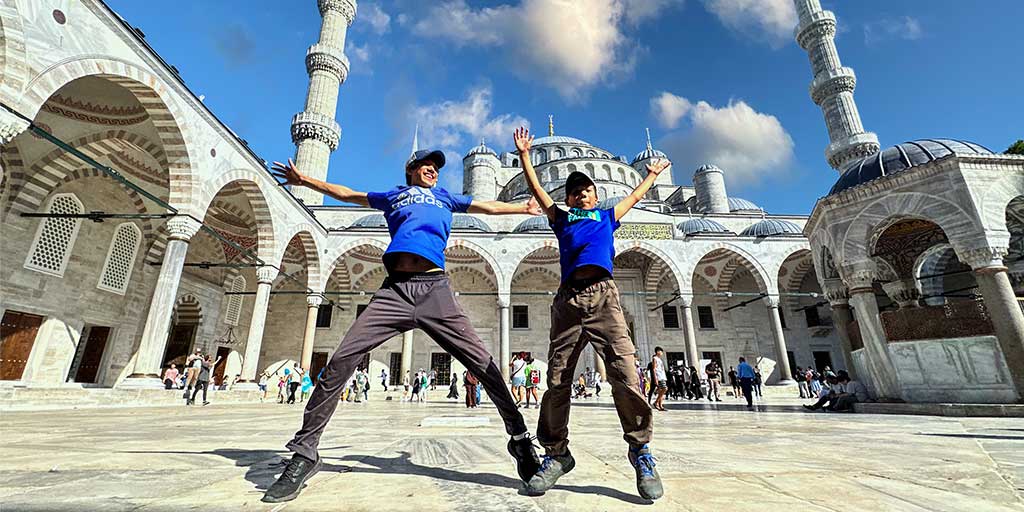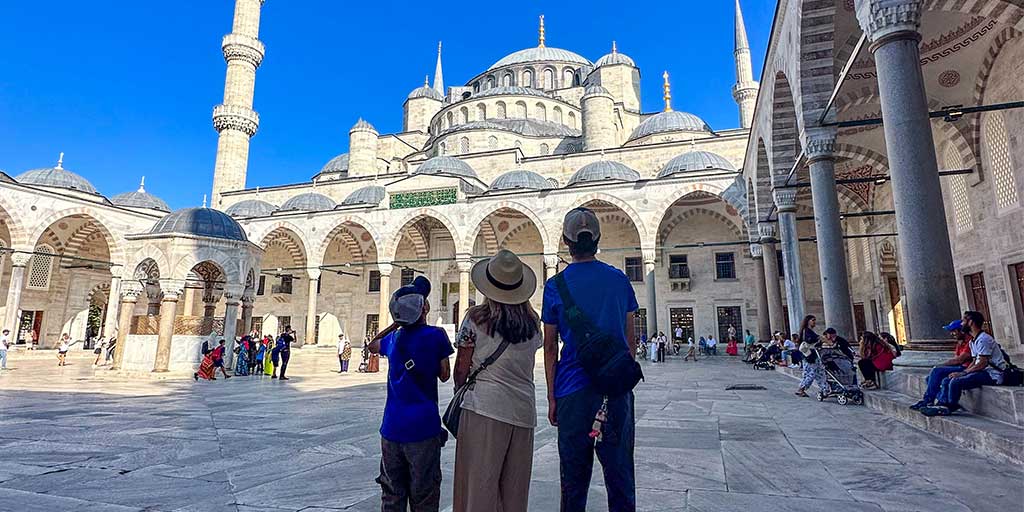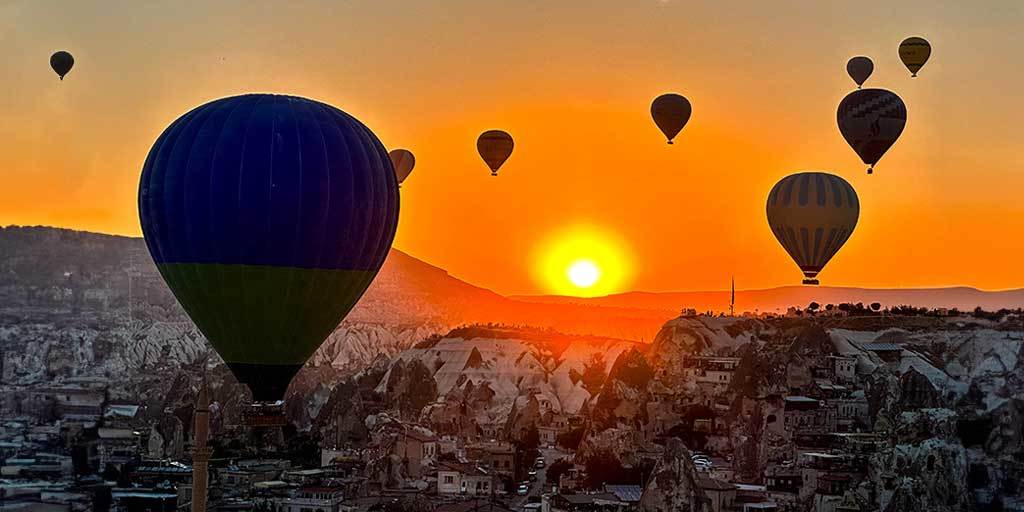Unlock the secrets of one of the world’s most beautiful places with our guide to the top things to do in Cappadocia, Turkiye. From awe-inspiring hot air balloon rides over fairy chimneys to exploring ancient underground cities and savoring authentic culinary delights, embark on an unforgettable journey filled with adventure.
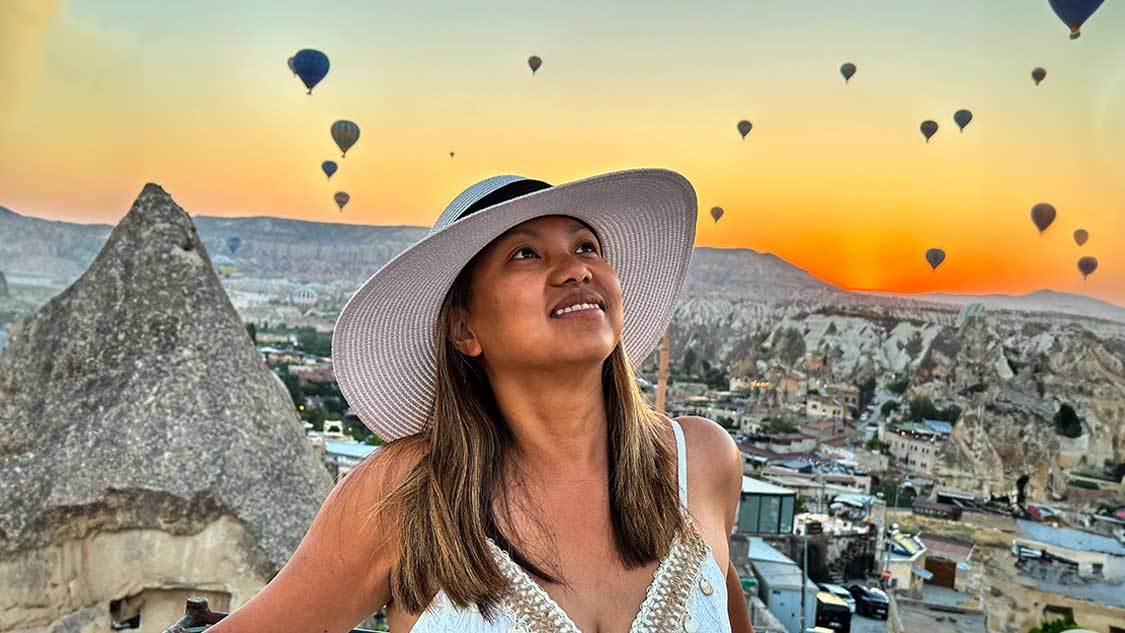
From otherworldly landscapes, jaw-dropping cave hotels, and fascinating underground cities, Cappadocia is, without a doubt, the most sought-after of all of the places to visit in Turkiye.
There are so many unique and unforgettable experiences in this region of the country that visitors might feel like their heads are spinning.
From the hidden churches and “fairy chimneys” of Goreme National Park to the legendary Cappadocia hot air balloon rides that helped shoot this remote region of Turkiye to fame, it’s a challenge to see all of the things to do in Cappadocia in just a single visit.
But if you want to maximize your time in the region and discover the best attractions in Cappadocia through the towns of Goreme and Urgu, you can plan a visit that isn’t just exciting and memorable. It has the potential to be one of the most incredible destinations of a lifetime.
After visiting Cappadocia with my family on our travels through Turkiye, we mapped out the best places to visit and the most awe-inspiring experiences to help others make the most of their time here.
We experienced some astounding adventures during our four weeks in the country, from the Turquoise Coast and Ephesus to watching the sunrise over Mount Nemrut and visiting the oldest human-made structure ever found in Gobekli Tepe. But Cappadocia stood out as one of our favorites.
These aren’t just Cappadocia’s top highlights. There are also some hidden gems that, from my research, few people have ever talked about. From cave hotels to hot air balloon rides, our Cappadocia guide should give you everything you need to know before visiting one of the most beautiful places in the world.
About Cappadocia
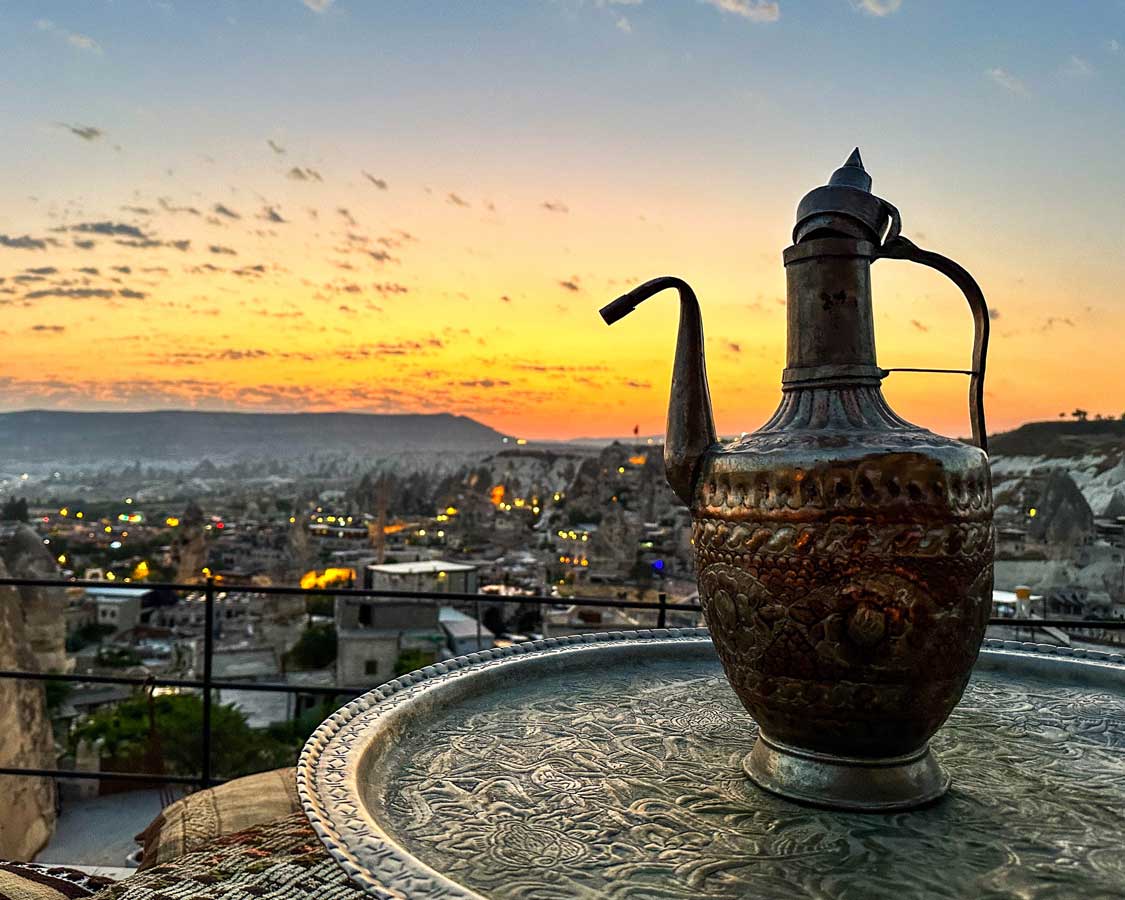
Cappadocia is a region of central Turkiye renowned for its otherworldly landscapes, historic towns, and unique cultural heritage.
Contrary to popular belief, Cappadocia is not a city. Rather, it’s a region that is made up of small cities and towns, including Göreme, Ürgüp, and Uçhisar, each offering its own unique charms and attractions.
The history of Cappadocia dates back centuries and is characterized by ancient civilizations, including the Hittites and Byzantines. However, Cappadocia’s most iconic features are its surreal rock formations, known as fairy chimneys, shaped by volcanic eruptions and erosion over millennia.
These whimsical formations have been used for centuries as homes, churches, and even hotels, creating an awe-inspiring and mystical atmosphere that attracts visitors from all corners of the globe.
Cappadocia’s popularity could easily be drawn from its history alone. Complex underground cities used to stave off attacks from invading armies lie just below the surface, and Byzantine-era frescoes line the walls of historic cave churches.
But Cappadocia offers much more than historical wonders. The natural beauty in the region’s valleys, dotted with rocky monoliths that have been dubbed “fairy chimneys,” and tourist attractions such as hot air balloon rides that take adventure-seekers on a serene ride right through these famous monuments have added to its allure.
Our Cappadocia Travel Vlog
Want to dive even deeper into all of the amazing places to visit in Cappadocia? Check out our Cappadocia Travel Vlog, where we explore Goreme, Urgup, and Kaymakli, exploring fairy chimneys, underground cities, hot air balloons, and all of the wonderful valleys that make Cappadocia one of the world’s most exciting travel destinations.
Our Cappadocia Travel Guide: Top Things to Do in Cappadocia
From monumental attractions to under-the-radar hidden gems, these are my absolute favorite things to do in Cappadocia.
Sunrise Hot Air Balloon Ride
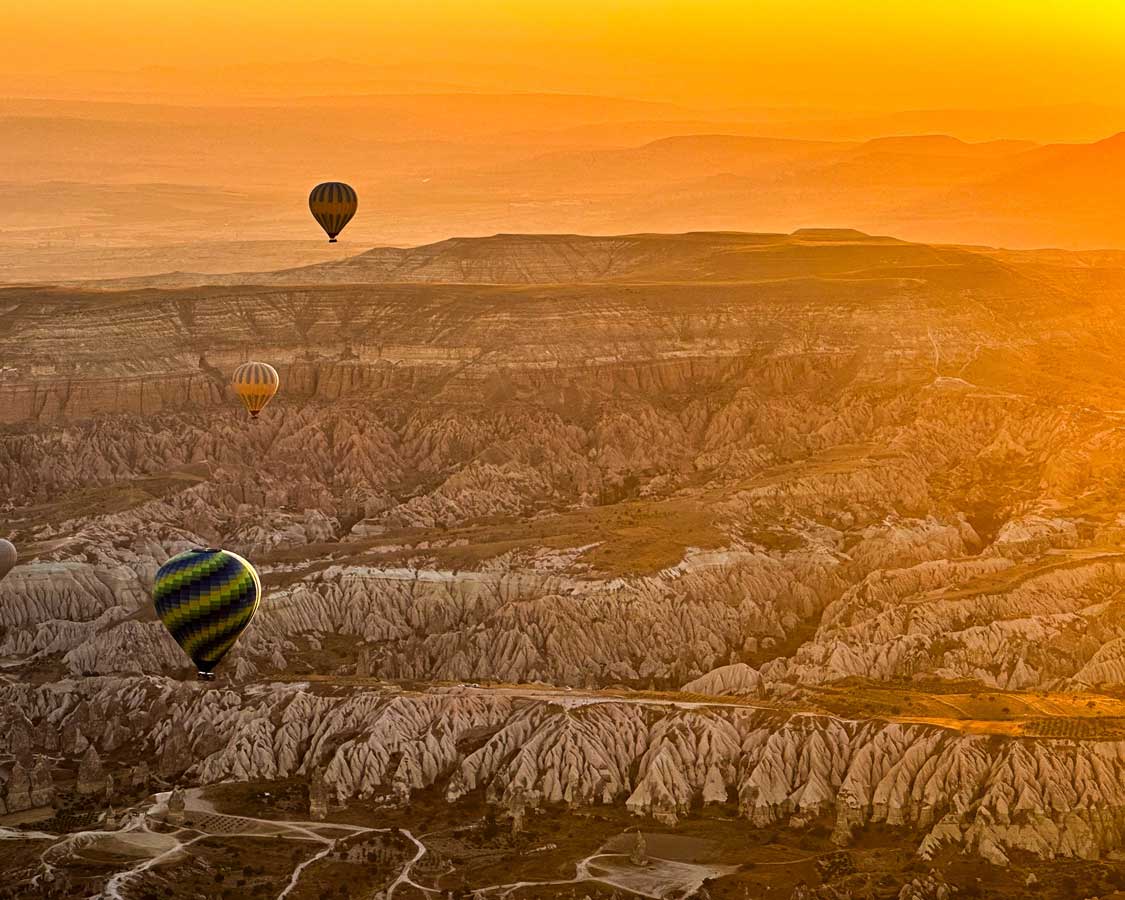
I don’t think that there is a more iconic image of Cappadocia than the view of hot air balloons floating effortlessly among the fairy chimneys of Göreme. People travel from all over the world and even from across Turkiye to enjoy this magical adventure.
There are many companies offering hot air balloon rides throughout Cappadocia, but the most popular are around Göreme and Ürgüp. We were staying in Ürgüp when we did our tour, but the balloons took us over the most popular sites, including Pigeon Valley and the town of Göreme itself.
Hundreds of hot air balloons launched within minutes of each other, filling the skies with glowing orbs. The experience itself is incredible (as we learned in our first hot air balloon ride in Luxor, Egypt). But the best views of the balloons actually come from the many hotel terraces sprinkled across the towns.
If you have a few days to spend in Cappadocia, spend one morning experiencing a hot air balloon ride for yourself and another morning watching the spectacle from the ground.
You can read our our tips for choosing the best Cappadocia hot air balloon tour here.
Stay In A Cave Hotel
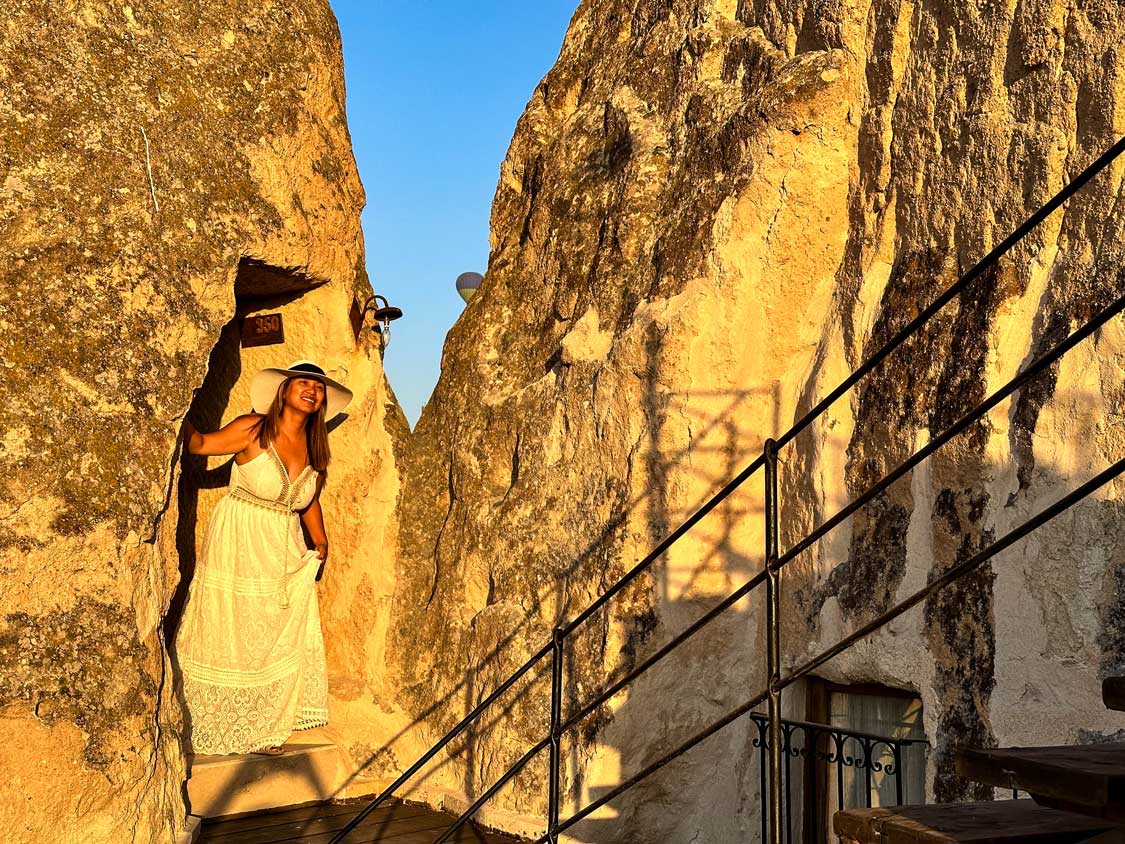
My family has been lucky enough to have stayed in some pretty unique hotels. From floating lodges in Thai rivers to Island retreats with outdoor showers, the cave hotels in Cappadocia stood out as some of the most unforgettable.
This is a region where the landscape has encouraged a unique approach to architecture. For centuries, locals have been using the region’s soft sandstone and elegant fairy chimneys as a base for building homes, churches, and even entire cities.
While my family was in Cappadocia, we stayed at two different cave hotels, and both were completely unique and unforgettable.
Divan Cave Hotel was our accommodation for two nights while we were in Göreme. This beautiful hotel had a hidden pool on the bottom floor of our room that hadn’t even been advertised prior to our arrival, so it was a complete surprise to us. It also had an incredible rooftop terrace with breathtaking views of the morning sunrise and hot air balloons.
While we were in Ürgüp, we stayed at the stunning Kayapaki Premium Caves Hotel. This incredible project is working to reclaim the former town of Kayapaki, which had been left in ruins after earthquakes and neglect.
This hotel is located in a more remote region of Cappadocia, but it still has access to many of the best things to do in Cappadocia. Kayapaki Premium Caves is an experience in and of itself. There are beautiful lavender gardens, incredible sunset views, and premium on-site restaurants. It’s also a heritage site where those staying at the hotel can explore the ruins of the former city.
You can find our guide to the best Cappadocia cave hotels right here.
Göreme Open Air Museum
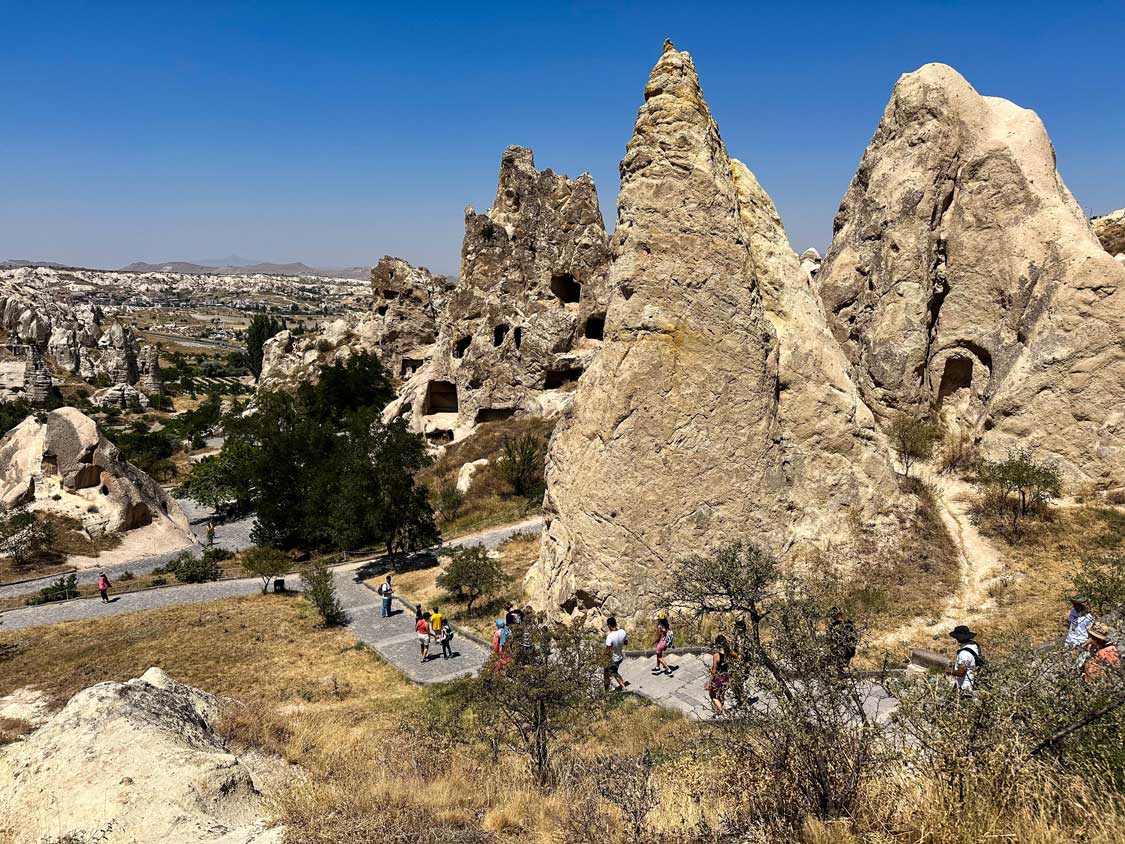
Step back in time among cave churches decorated with detailed frescoes that were dug into the volcanic hills during the Middle Ages.
The Göreme Open Air Museum is within easy 1-mile walking distance of the city center, although it’s along a busy road, so getting here by taxi might be a bit safe. This complex features some of the region’s most famous chapels, including the Apple Church, the Chapel of St. Barbarra, the Chapel of St. Catherine, and the ominously named “Dark Church.”
These are among the most important Byzantine-era churches in the region. The caves and nearby homes were carved out by monks and nuns who escaped to Cappadocia to follow their monastic lifestyles. The outdoor museum was listed as a UNESCO World Heritage Center in 1985.
The Dark Church holds some of the most well-preserved frescoes. Because of that, there is an additional entrance fee. But seeing the paintings in excellent condition is worth the minimal extra cost. Pay attention to the eyes, many of which were carved out by Romans and Muslims who did not like the idea of the painted figures “looking at them.”
Cappadocia Valleys
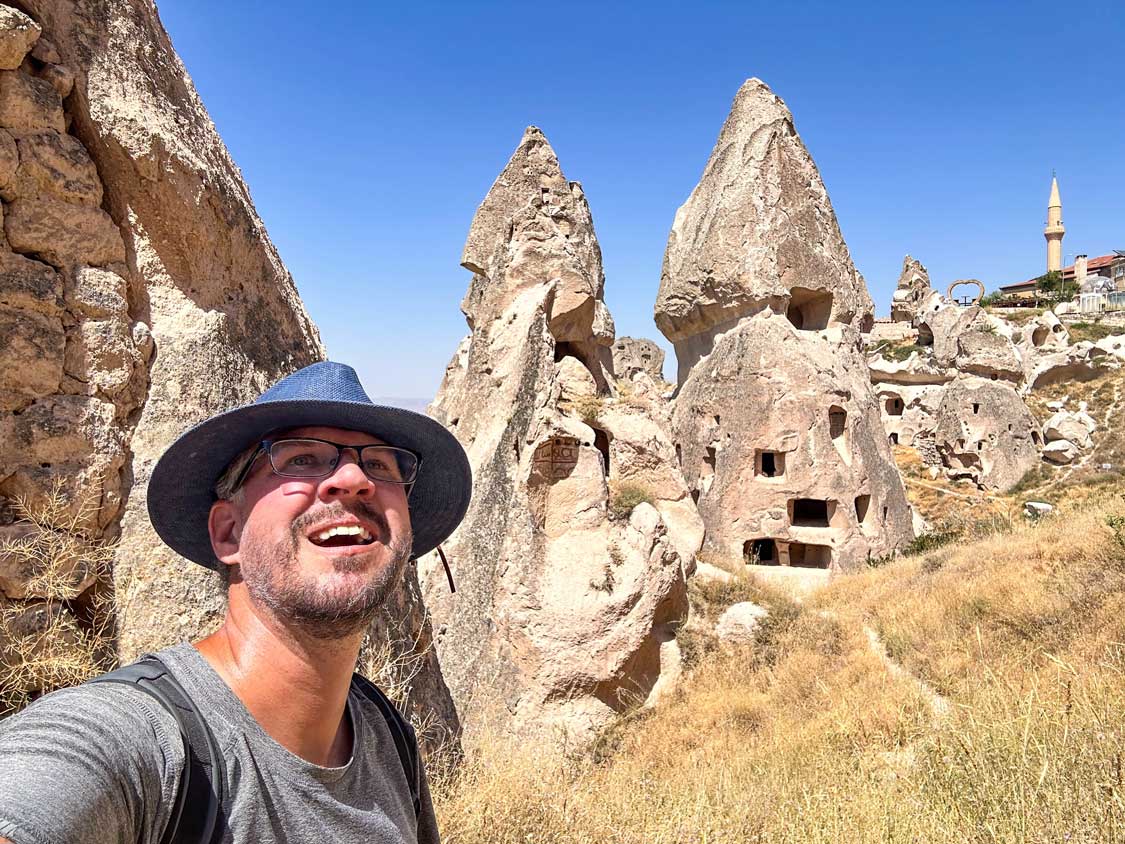
Hiking and cycling are very popular ways to explore the valleys surrounding Cappadocia, but there are also plenty of tours that will take visitors through some of the most scenic and otherworldly landscapes that fill the region.
Whether you want to explore the valleys of Cappadocia by horseback, on foot, or by ATV, all of these incredible experiences are within easy reach. The ten most famous valleys in Cappadocia can be explored on tours in a day or two or on your own over a few days.
All of the Cappadocia valleys are within six miles of Goreme. Each one is unique and offers a completely different experience.
Most of the valleys have free admission with a few exceptions, so if you’re looking to explore Cappadocia on a budget, they make for excellent options.
- Pigeon Valley: Throughout Cappadocia, pigeon holes, where farmers in the region used to breed the birds, can be seen everywhere. But there is nowhere that they are more prominent than Pigeon Valley. Toss seeds (which you can buy from vendors on-site) to the birds and watch them soar across the scenery.
- Love Valley: Famous for its “phallic-shaped rock formations, the striking landscape of Love Valley is one of the coolest places to visit in Cappadocia. But what stood out for us here was that there is a local couple, Arife and Hassam, who refused to sell their property when Turkiye turned the area into a national park. They live just beneath the markets in a self-made cave and are the last couple in Love Valley.
- White Valley: Connected to Love Valley, it’s often hard to know when you leave one and enter the other. But for those hiking or biking through Cappadocia, you’ll pass through here to access Uchisar Castle. It’s known for its bleached rock, giving it the “White Valley” name.
- Imagination Valley (Devrey Alley): This small valley is famous for its rock formations, like the “kissing camels” and others that look like camels, snakes, seals, and dolphins. My boys had an absolute blast running through and climbing over the mazelike structures.
- Monks Valley: Located between the Zelve Open Air Museum and Goreme are Monks Valley and Pasabag Valley. Pasabag is a destination in and of itself, so I’ll get to that one later in the article. It’s a nice valley, but not the most beautiful. Monks Valley makes a nice addition to a stop in Pasabag, but I wouldn’t come here just for it alone.
- Sword Valley: This is the smallest of all of the valleys in Cappadocia. But don’t let its size fool you. It’s also home to the longest tunnel in the region.
- Red Valley: The valley gets its name from the vibrant hues of the rocks, especially during sunrise and sunset, creating a picturesque landscape that’s a paradise for hikers and nature enthusiasts. It’s especially popular for sunset ATV rides.
- Rose Valley: Popular for its rose-tinted rock formations that seem to “shimmer” in the sunlight. This picturesque valley captivates visitors with its gentle pink and reddish hues, particularly striking during sunrise and sunset.
- Meskindir Valley: This shady trail takes hikers through several cave houses and small historic sites as well as several tunnels.
- Zemi Valley: This 3.75-mile hike begins in Goreme and follows a small stream past cave houses and rock arches. Not many people take the time to visit Zemi Valley, and I haven’t seen it on any of the local tours, so it’s a real Cappadocia hidden gem.
Red Valley Sunset Viewpoint
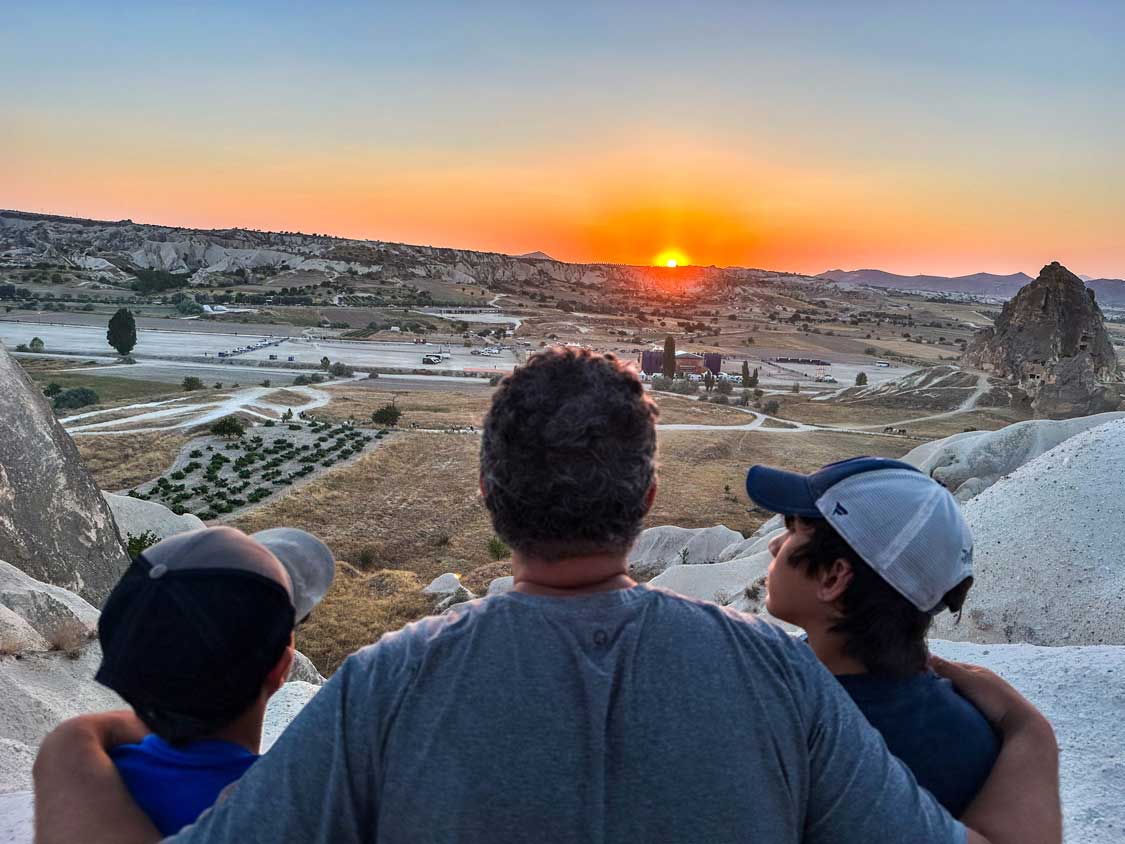
While the hot air balloons at sunrise might be the most famous of the Cappadocia attractions, the region’s sunsets are just as beautiful. And if you love a clean, clear sky, sunset at the sunset viewpoint in Red Valley is where it’s at.
This area is where most of the horseback riding and sunset ATV tours end. So it’s packed almost every night during the high season. But there’s lots of space, so you’ll be able to find a little area of your own to relax or join the celebration with the throngs of people taking in the views.
Çavuşin Castle & The Church of St John the Baptist
If you love under-the-radar attractions, Çavuşin Village is a very cool place to visit in Cappadocia. The small Çavuşin village is one of the oldest settlements in Cappadocia. It’s most famous for its 5th Century church of St. John the Baptist, whose tomb my family saw when we were in the town of Selcuk the week before.
The church is the oldest and largest of its kind in Turkiye and is located about 20 minutes north of Göreme.
Nearby is the stunning Çavuşin Castle. The incredible building was built into the side of a cliff and looks like it’s just an extension of the mountain. From the lower side, you can explore the buildings and shops of the village. But from the upper side, you can actually access the viewpoint from the top of the castle.
Underground Cities
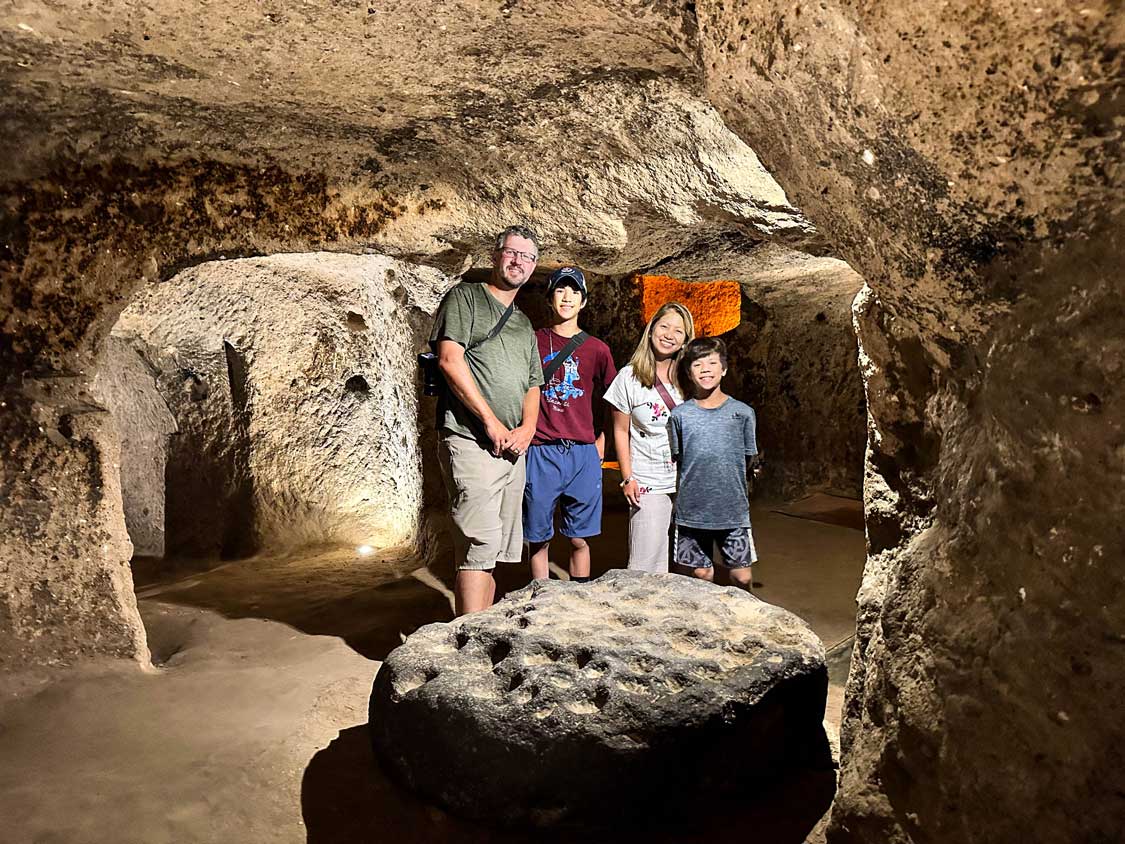
One of the most fascinating and unique aspects of Cappadocia is the underground cities sprinkled throughout the region.
When I say “cities,” I mean just that. These weren’t villages. Some were home to up to 20,000 people, all living together up to nearly 300 feet below the surface. These were carved out into the soft volcanic rock and served as refuge and protection for thousands of people during times of war and invasion.
The underground cities in Cappadocia date back to the Hittite era, nearly 2,800 years ago. They were expanded by early Christians fleeing persecution. The cities feature an intricate network of tunnels, rooms, ventilation shafts, and communal spaces that are spread across many levels.
There are three major underground cities in Cappadocia.
Derinkuyu: Among the most expansive and well-known of all of the underground cities in Cappadocia, Derinkuyu descends eight levels beneath the surface. It is believed to have housed around 20,000 people along with their livestock.
This city contains chapels, wine presses, stables, and ventilation shafts, showcasing its remarkable architectural and engineering marvels.
Kaymaklı: This is one of the most popular underground cities in Cappadocia due to the higher ceilings that allow taller people (like me) to move around safely. The city is carved across four levels, although only four of its levels are open to the public. It features various chambers for living, storage, and worship, along with ventilation shafts and a complex network of tunnels and passageways.
Özkonak: This lesser-known underground city is smaller in size compared to Derinkuyu and Kaymaklı. Özkonak offers a glimpse into the underground life of ancient inhabitants with its distinctive architectural elements, including ventilation shafts, living quarters, and communal spaces spread across multiple levels.
Uçhisar Castle
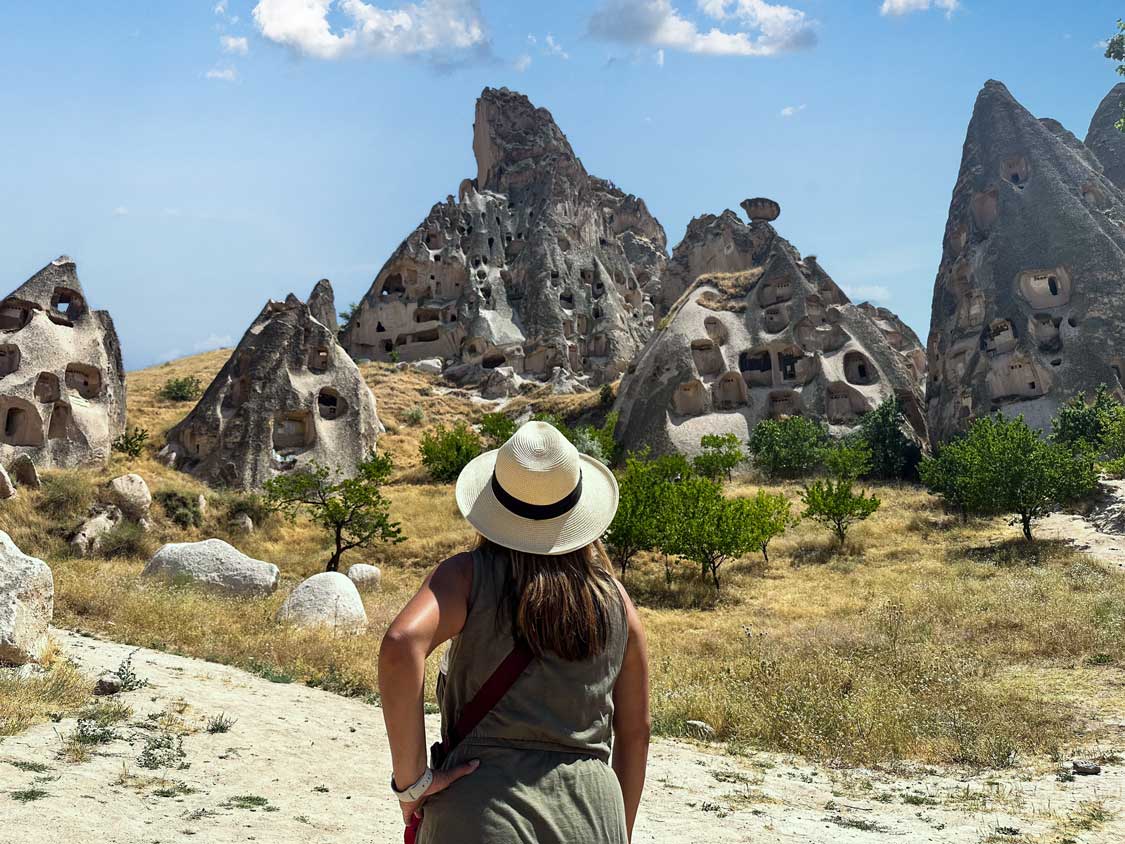
Towering above the Cappadocia landscape, Uçhisar Castle is the highest point in the region. This massive complex of houses, churches, and battlements was built into the side of a hill and acted as the main point of defense in the city.
It’s so large that it’s believed to have once housed 1,000 soldiers and military personnel.
Much of the castle is worn down after centuries of wind and water erosion, but Uçhisar Castle makes for a fascinating place to explore and take in a unique aspect of the region. It was one of the most interesting and easy-to-explore things to do in Cappadocia.
Most visitors spend their time in the main castle, but if you follow the trails around the structure, you’ll find a collection of small churches that very few people ever visit. Some of them still have frescoes on the walls.
Eat A Testi Kebab
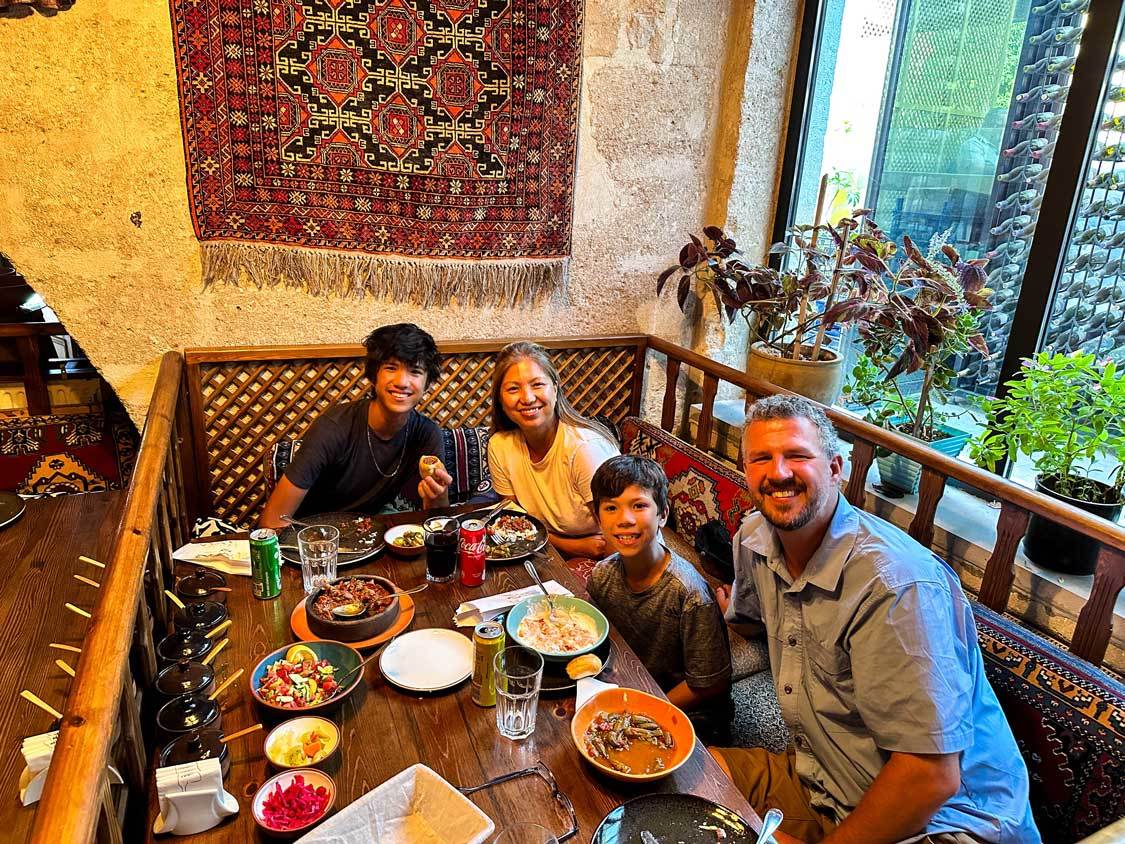
If you love trying all of the food in Turkiye, you’ll want to try a Testi Kebab. This traditional Turkish dish originated in Cappadocia and is famous for its rich flavor.
The term “Testi Kebab” loosely translates to “pottery kebab,” and it comes from the method by which the dish is prepared and served.
A clay pot is packed with chunks of lamb or chicken along with an assortment of vegetables such as potatoes, carrots, onions, and tomatoes and then seasoned with herbs. The pot is then sealed with dough to trap steam inside and then is buried in hot coals, which slowly cook the ingredients in their own juices, infusing the flavors. The pot is then cracked in front of the diner, unveiling an aromatic and steamy delight.
One of the restaurants in Cappadocia best known for the Testi Kebab is Dibek Restaurant at Cami Sk. and Beldiye Cd. Their high-end but relaxed atmosphere and friendly staff just added to the amazing taste.
Sunset ATV Tour
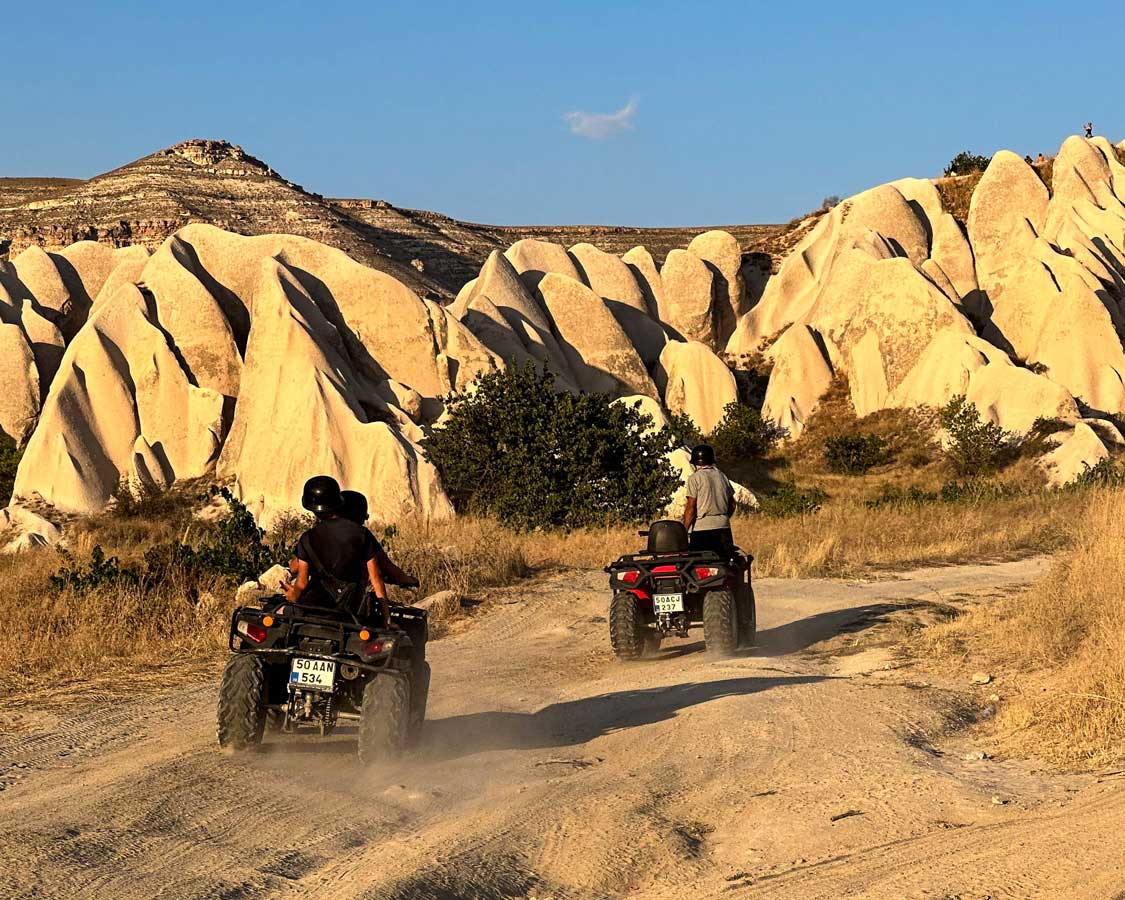
When we were staying in Ürgüp, Christina and I took the boys out for a sunset ATV ride through the Rose Valley. It was an incredible way to spend an evening.
The cool evening air was a much-deserved contrast to the hot sun of mid-day when we did most of our exploring. The ATV tour lasted about two hours and came to an end at the Red Valley sunset viewpoint, where I spent the last hour drinking in the unbelievable beauty of Cappadocia at sunset.
Along with the ATV ride and sunset stop, we also had the chance to check out some parts of Goreme Historical National Park with its fairy chimneys and cave houses.
Ihlara Valley
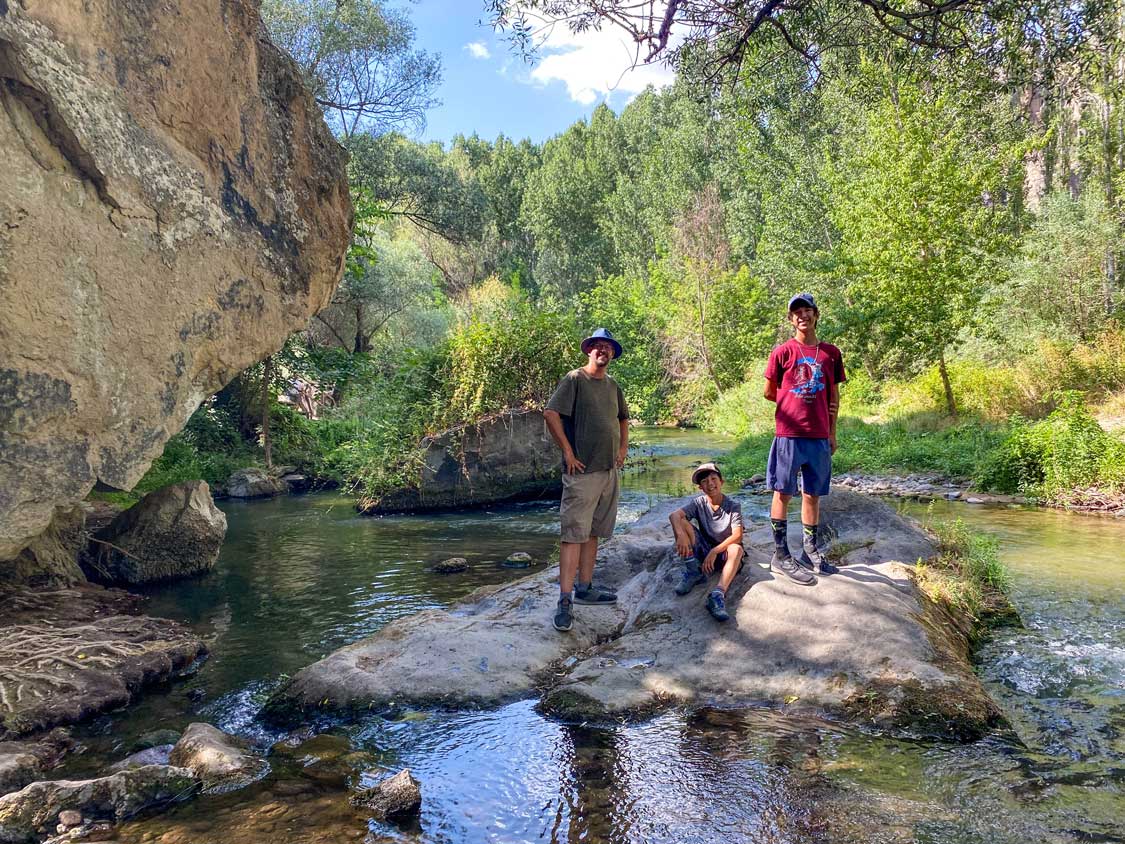
Our visit to Cappadocia was in mid-August. The summer heat was intense, sometimes reaching over 100 degrees. There’s very little shade or vegetation in Cappadocia, so apart from exploring the castles and underground cities, there isn’t much escape from the sun.
Unless you visit Ihlhara Valley.
This incredible gorge is 10 miles long and has been carved out over centuries by a gently flowing river. With towering cliffs on both sides, the gorge has plenty of shade. And it’s absolutely teeming with large shade trees and beautiful flowers.
The walk along the bottom of the gorge is beautiful and peaceful. And it’s a relatively easy stroll that’s gentle enough for most people. However, it is not wheelchair or stroller-friendly.
It’s not just natural beauty that makes the Ihlara Valley one of the top places to go in Cappadocia though. There are 105 churches carved into the cliffs within the gorge. Sixteen of these churches are open for visitors to explore.
Many of the Ihlara Valley churches still have detailed frescoes and paintings in excellent condition. You can read our guide to the Ihlara Valley here.
Pasabag
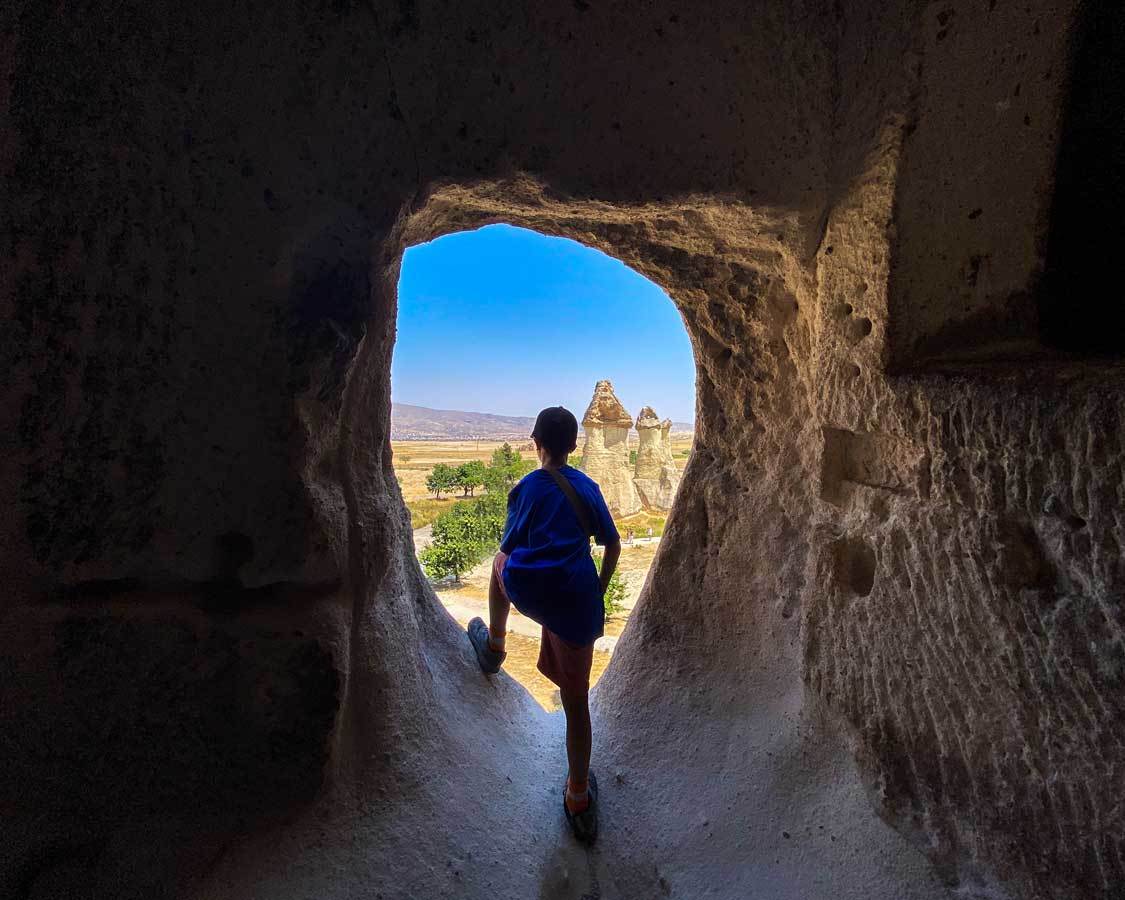
Earlier, I listed off some of the coolest valleys in Cappadocia. But there’s one valley that I wanted to make sure that I gave special attention to. And that is Pasabag Valley.
Pasabag is one of the most popular spots to visit in Cappadocia. The valley is packed with fairy chimneys, hermit houses, and churches. And it has a truly fascinating history. It’s believed to be where Saint Symeon lived shortly after he converted to Christianity.
The caves here are relatively open to explore, and the boys found several places where they were able to climb up to the second floor of some of the cave houses for incredible views of the surrounding area.
Whirling Dervish Ceremony
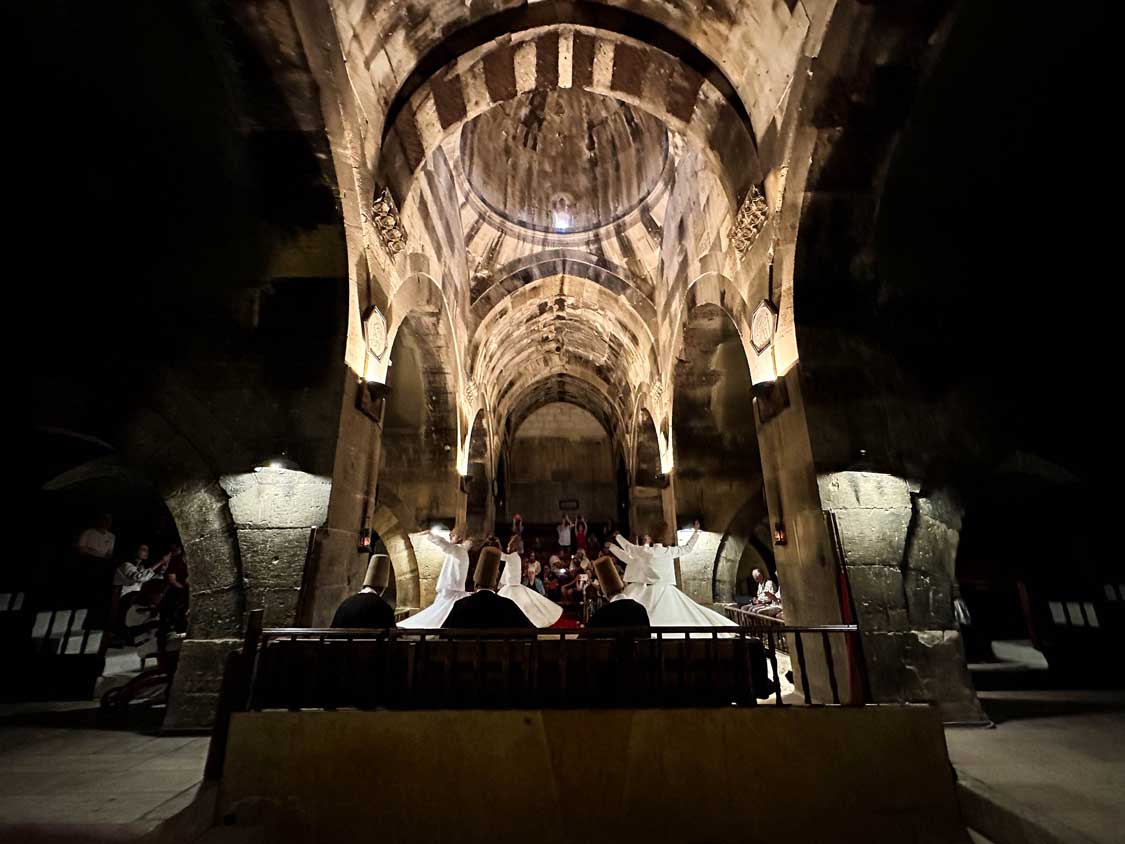
Whirling Dervish shows can be found throughout much of Turkiye. But there are few places where you can witness a traditional Whirling Dervish ceremony.
Sufism is a mystical religion that originated in the 13th century, where trained mystics perform a ritual known as the Sema. During this ceremony, the Whirling Dervishes perform a musical and spinning dance in which the dancers enter a meditation-like trance.
The hypnotic whirling motion and the transcendent atmosphere is mesmerizing.
Where Whirling Dervish shows are performed by dancers and musicians, Whirling Dervish ceremonies are the real thing. Where the goal of the dancers is to enter that trance-like meditation. And in Cappadocia the proper ceremony takes place at a 13th Century Caravanserai called Saruhan, about 30 minutes from Goreme.
You can book that experience here.
Selime Cathedral
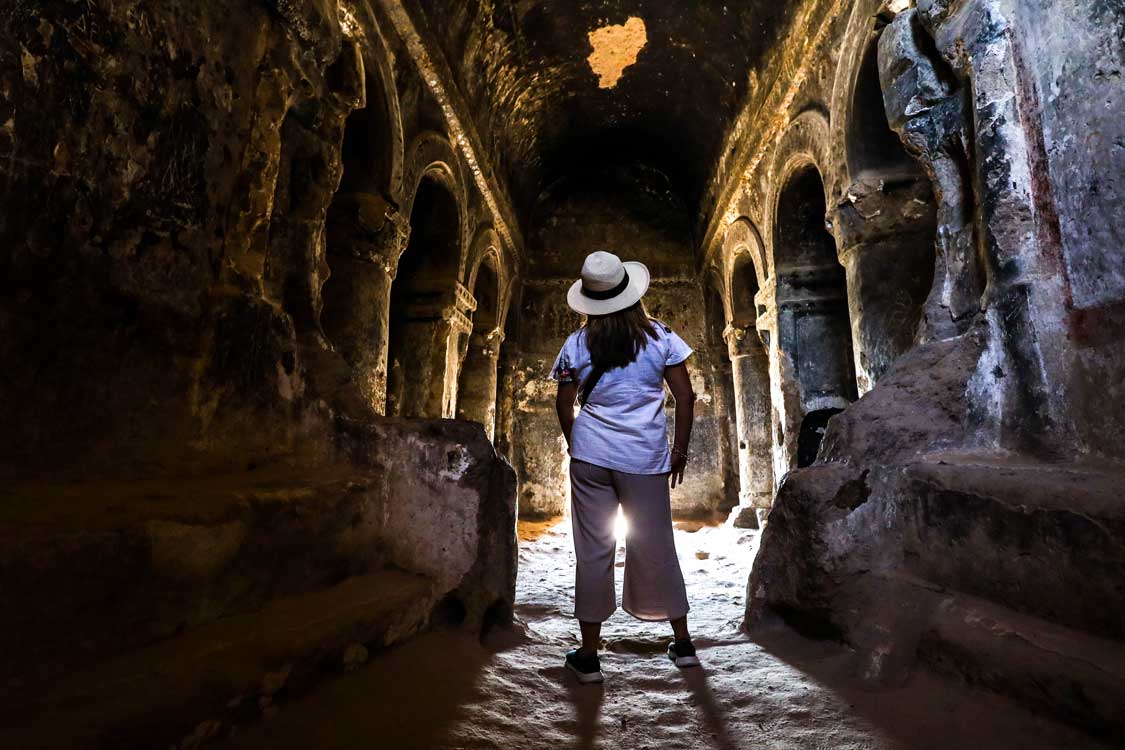
If you love off-the-beaten-track attractions, Selime Cathedral is an amazing place to explore. This testament to human craftsmanship and spiritual devotion is tucked amidst the fairy chimneys and rock formations between the towns of Selime and Yaprakhisar.
This awe-inspiring rock-cut cathedral is carved into the towering cliffs of volcanic tuff and offers some of the most intricate interior design work of any cave church within Cappadocia.
Selime Cathedral was a place of worship and refuge for early Christians during the Byzantine era. Its grandeur and complexity are on full display with intricate columns, arches, and vast chambers that once held religious ceremonies and gatherings.
Hammam
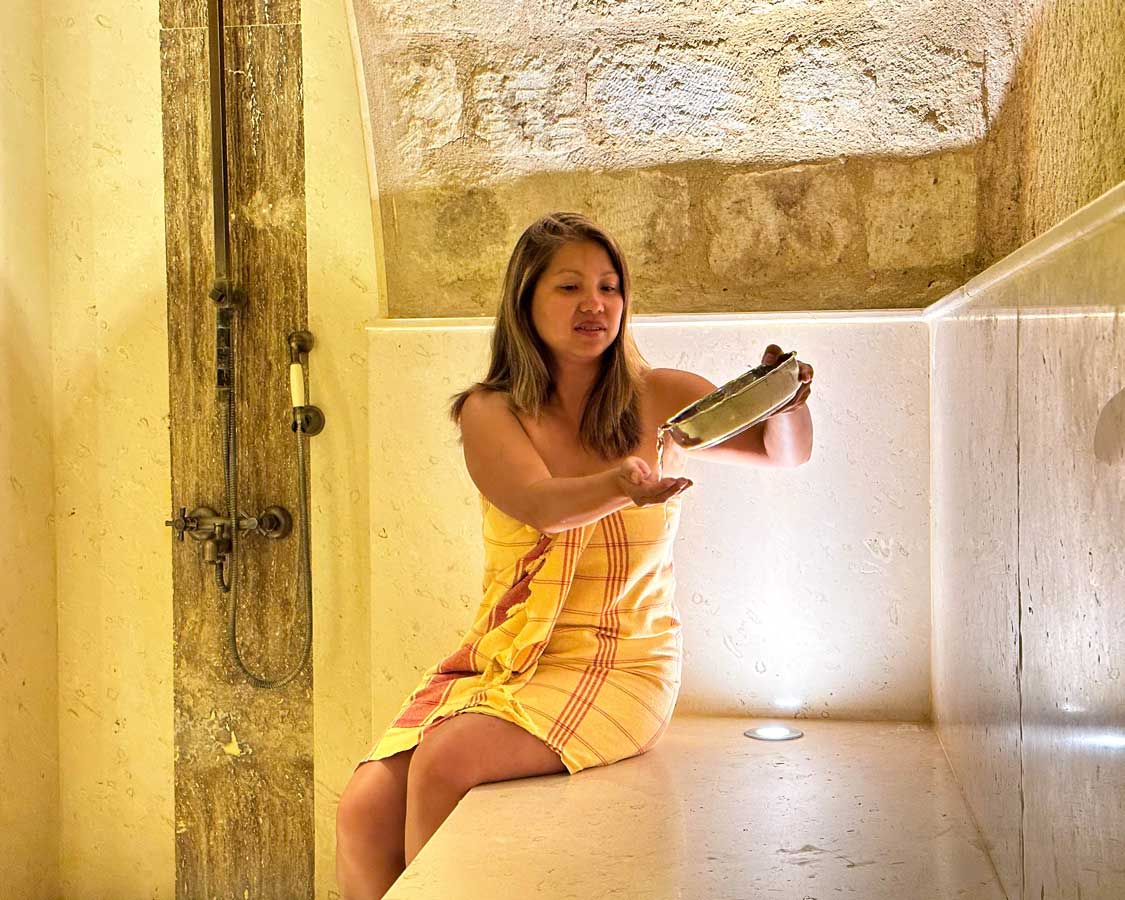
Exploring all of the amazing things in Cappadocia is hard work. And if you want to relax after a hard day of hiking, wandering, and learning, there’s nothing better than a traditional Turkish hammam.
This rejuvenating experience is steeped in centuries of history. The therapeutic ritual is deeply rooted in Turkish culture and is renowned for its revitalizing effects on the body and spirit.
The hammam experience dates back to Ottoman times. It’s a communal bathing ritual that involves cleansing and relaxing techniques in a heated, steam-filled environment.
With a combination of gentle heat, steam, and skillful massages, the hammam ritual not only purifies but promotes a profound sense of well-being.
Our Guide To Cappadocia, Turkiye
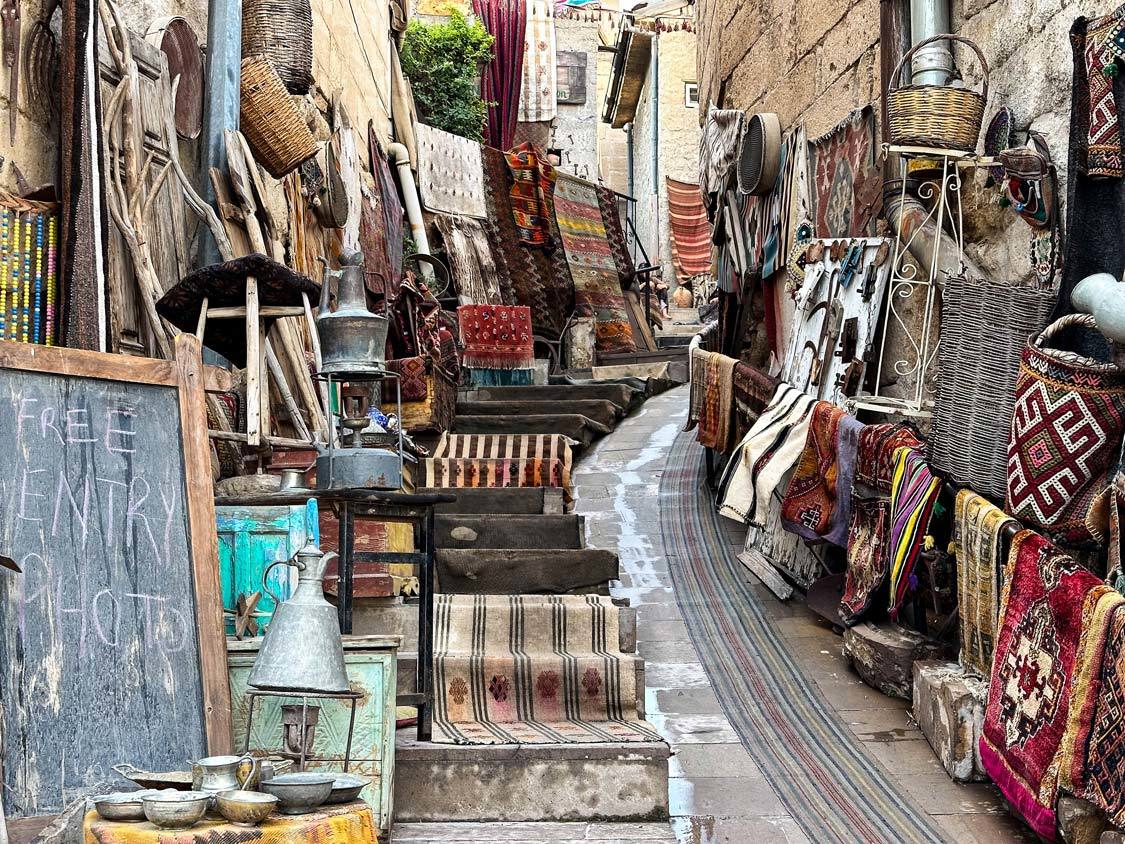
How To Get To Cappadocia
Cappadocia lies in the Neveshir Province in central Turkiye. It’s made up of several small cities, towns, and villages, the largest of which are Göreme, Ürgüp, and Uçhisar. The region reaches from the town Avanos in the South, northward toward Ihlaara Canyon.
There are several common ways to get to Cappadocia, Turkiye. The region’s popularity and central location mean that it’s well connected to large cities throughout the country.
Once in Cappadocia, local transportation options like taxis, rental cars, or organized tours are available to navigate and explore the region’s towns, attractions, and natural wonders.
Cappadocia By Air
The most common and convenient way to reach Cappadocia is by flying into one of the nearest airports, either the Nevşehir Kapadokya Airport (NAV) or Kayseri Erkilet Airport (ASR).
These airports have regular domestic flights from major cities in Turkiye, including Istanbul, Ankara, and Izmir. Upon arrival, visitors can take a shuttle or taxi or arrange for a private transfer to reach Cappadocia’s various towns, such as Göreme or Ürgüp, which are roughly a 30-60 minute drive away from the airports.
Cappadocia By Bus
For those traveling in Turkiye on a budget or arriving from smaller towns or remote regions, reaching Cappadocia by bus is an option. Bus routes run from major cities like Istanbul, Ankara, or other regions of Turkiye.
Several bus companies operate daily services to towns in Cappadocia, offering a comfortable and affordable mode of transportation. The journey duration varies based on the departure location, but it generally takes around 10-12 hours from Istanbul and 4-5 hours from Ankara.
Cappadocia by Car
For those who are driving in Turkiye or prefer flexibility and independence, renting a car and driving to Cappadocia is also an option. The region is accessible by well-maintained roads from major cities in Turkiye. The drive to Cappadocia allows travelers to explore the scenic routes and stop at various points of interest along the way.
Visiting Cappadocia With Kids
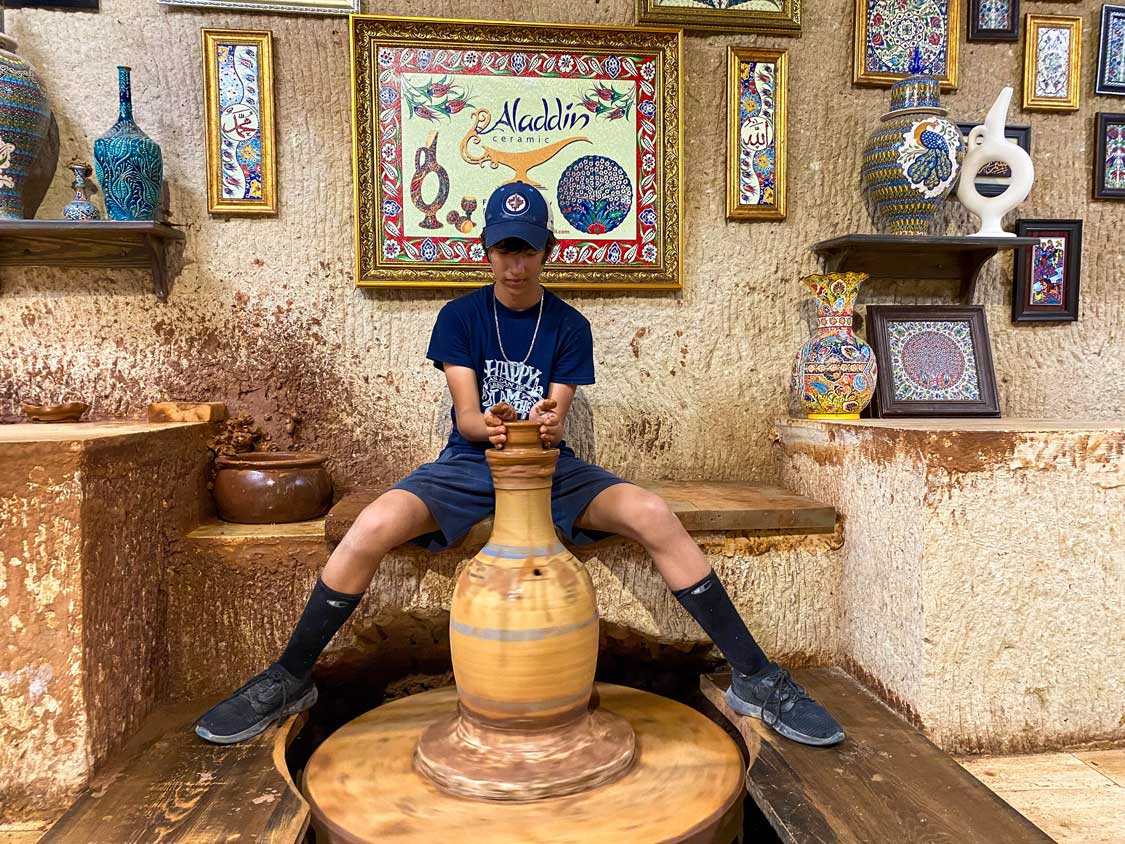
My visit to Cappadocia was on a month-long family trip through Turkiye that took us to some pretty incredible places. Cappadocia was absolutely incredible to visit with kids, but there are some things you should know before you go.
My kids were 12 and 10 during our time in Cappadocia.
Hot Air Balloon Ride Considerations: While hot air balloon rides are a signature experience in Cappadocia, they might not be suitable for younger children due to age and height restrictions.
Most hot air balloon rides will accommodate children as young as 5 or 6. However, they won’t be able to see over the side of the basket. Ask the company whether they have viewports for smaller children.
If you plan to take a hot air balloon ride without your kids, ensure childcare arrangements or activities are available for the kids during this time. Additionally, consider early morning balloon flights so that after the experience, you have the rest of the day for family-friendly activities. You can read our tips for hot air balloon tours in Cappadocia here.
Exploring Underground Cities and Fairy Chimneys: Kids often love exploring intriguing spaces, and the underground cities and fairy chimneys in Cappadocia can spark their curiosity.
However, keep in mind that some underground tunnels might be narrow or have low ceilings, so supervision and caution are essential. Opt for visits to underground cities like Kaymaklı or Derinkuyu, which are more accessible and have guided tours suitable for families.
Take Family-Friendly Hikes: Cappadocia offers various hiking trails suitable for families. Consider exploring places like Rose Valley or Pigeon Valley, which offer relatively easy and scenic hikes with captivating landscapes.
These trails provide ample opportunities for kids to run around, discover unique rock formations, and enjoy the natural beauty of the region.
Participate in Pottery Workshops: Engage your kids in a fun and educational activity by enrolling them in a pottery workshop. Cappadocia is famous for its pottery, and many places offer workshops where children can learn the art of pottery-making and create their own masterpieces under guidance.
We had a blast at our pottery workshop, and there was no pressure to buy anything when we left. You can sign up for one of these workshops here.
Choose Family-Oriented Accommodations: Opt for family-friendly accommodations such as hotels or cave guesthouses that consider the needs of families. Look for places that offer spacious rooms or family suites, outdoor areas for kids to play, and perhaps even activities or entertainment options specifically designed for children.
Cappadocia is not Stroller-Friendly: Cappadocia is incredible, but with all of the caves and wild landscapes, it’s not a great place for strollers and wagons. If you have small children, I’d highly recommend bringing along a child carrier backpack. You can check out my yearly guide to the best kid carriers here.
We stayed at Divan Cave Hotel in Göreme and Kayapaki Premium Caves in Ürgüp. Both were fantastic.
Remember to pace your itinerary to accommodate children’s rest, meals, and playtime needs. With its unique landscapes and rich history, Cappadocia offers a wealth of experiences that can captivate both adults and kids, creating lasting memories for the entire family.
Tips For Family Travel In Turkiye
Family travel in Turkiye, especially in places like Sanliurfa and the Southeast, requires some planning and a little bit of luck. Some areas of this country can be closed due to political unrest, so it’s always a good idea to check out current travel advisories and stay informed of the current travel status.
Check out our Turkiye Family Travel Blog for everything that you need to know about family travel in Turkiye and watch ouf Tips for Family Travel in Turkiye video below to help you plan an unforgettable visit to this mesmerizing and wonderful country.
You’d be doing us a huge favor if you could hit the like and subscribe buttons.
Enjoy Your Time In Cappadocia, Turkiye
There’s no denying that Cappadocia is one of the most unforgettable places to visit in Turkiye. This region is absolutely jam-packed with stunning views and unimaginably wonderful experiences. When you visit, make sure to give yourself a few days in Cappadocia to fully appreciate just how special it is.
After our our visit to Cappadocia, we made our way to the far east of Turkiye to experience the wonders of Mount Nemrut, the world’s oldest man-made structure at Gobekli Tepe, and the ancient city of Sanliurfa.
You can find more great information about visiting Turkiye on our Turkiye Family Travel Blog. Or feel free to join our Family Travel Support Group on Facebook. You can connect with more family travelers just like you who love to explore the world.
Wandering Wagars is a participant in the Amazon Services LLC Associates Program, an affiliate advertising program designed to provide a means for sites to earn advertising fees by advertising and linking to amazon.com, amazon.co.uk, amazon.ca. Amazon and the Amazon logo are trademarks of Amazon.com, Inc. or its affiliates
You May Also Like To Read:

